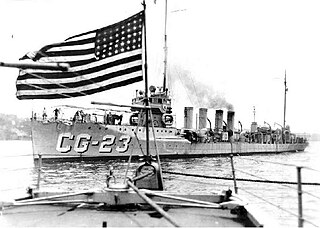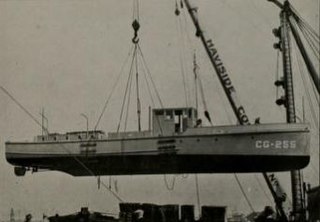
The Tucker class of destroyers was a ship class of six ships designed by and built for the United States Navy shortly before the United States entered World War I. The Tucker class was the fourth of five classes of destroyers that were known as the "thousand tonners", because they were the first U.S. destroyers over 1,000 long tons (1,016 t) displacement.

USCGC Onondaga (WPG-79), a United States Coast Guard cutter, was built by Defoe Boat Works in Bay City, Michigan, commissioned on 11 September 1934. From its commissioning until 1941, Onondaga was stationed at Astoria, Oregon, where she performed important law enforcement duties and rendered much assistance to ships in distress. Each year she patrolled the annual pelagic seal migration to the Pribilof Islands, and she attempted to prevent out of season halibut fishing.

YP-26 was a former U.S. Coast Guard wooden patrol boat which saw later duty with the U.S. Navy until destroyed in a 1942 accident.

The United States Coast Guard wooden-hulled 75-foot patrol boats were built during Prohibition to help interdict alcohol smugglers. Their nickname was derived from the slang term "six bits" meaning 75 U.S. cents.

USS YP-16 was a wooden-hulled patrol vessel in commission in the fleet of the United States Coast Guard as CG-267 from 1925 to 1934, and in the fleet of the United States Navy as YP-16 from 1934 until 1941. She was sunk by Japanese aircraft during the Japanese attack on Guam.

USS YP-17 was a wooden-hulled patrol vessel in commission in the fleet of the United States Coast Guard as CG-275 from 1925 to 1933, and in the fleet of the United States Navy as YP-17 from 1933 until 1941. She was captured by Japanese forces during the Japanese attack on Guam.
USCGC Hemlock (WAGL-217) was a lighthouse tender in commission in the fleet of the United States Lighthouse Service as USLHT Hemlock from 1934 to 1939, and in the fleet of the United States Coast Guard as USCGC Hemlock from 1939 to 1958. During World War II, she was given the additional designation (WAGL-217).

USS YP-19 was a wooden-hulled patrol vessel in commission in the fleet of the United States Coast Guard as CG-177 from 1925 to 1934, and in the fleet of the United States Navy as YP-19 from 1934 until 1945.

USS YP-18 was a wooden-hulled patrol vessel in commission in the fleet of the United States Coast Guard as CG-263 from 1925 to 1934, and in the fleet of the United States Navy as YP-18 from 1934 until 1938.

USS YP-10 was a wooden-hulled patrol vessel in commission in the fleet of the United States Coast Guard as CG-194 from 1925 to 1934, and in the fleet of the United States Navy as YP-10 from 1934 until 1941.

USS YP-15 was a wooden-hulled patrol vessel in commission in the fleet of the United States Coast Guard as CG-149 from 1925 to 1933, and in the fleet of the United States Navy as YP-15 from 1933 until 1945.

USS YP-45 was a wooden-hulled patrol vessel in commission in the fleet of the United States Coast Guard as CG-133 from 1925 to 1934, and in the fleet of the United States Navy as YP-45 from 1934 until 1945.
CG-107 was a wooden-hulled patrol vessel in commission in the fleet of the United States Coast Guard.
CG-113 was a wooden-hulled patrol vessel in commission in the fleet of the United States Coast Guard.
CG-108 was a wooden-hulled patrol vessel in commission in the fleet of the United States Coast Guard.
CG-249 was a wooden-hulled patrol vessel in commission in the fleet of the United States Coast Guard.
New York Yacht, Launch & Engine Company was a shipyard located on the Harlem River in the Morris Heights neighborhood of the Bronx.
Rice Brothers Corporation was a shipyard located in East Boothbay, Maine that operated from 1892 until 1956.

USS YP-51 was a wooden-hulled patrol vessel in commission in the fleet of the United States Coast Guard as CG-261 from 1925 to 1934, and in the fleet of the United States Navy as YP-51 from 1934 until 1945.

CG-74339 was a wooden-hulled patrol vessel in commission in the fleet of the United States Coast Guard.








